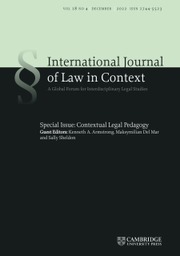Article contents
Representing Canadian justice: legal iconography and symbolism at the Supreme Court of Canada
Published online by Cambridge University Press: 02 May 2017
Abstract
This paper examines the intersection between a distinctly Canadian legal culture and the legal architecture, symbolism and iconography of its Supreme Court building in Ottawa. I begin from the premise originally put forward in Resnik and Curtis’s study of legal architecture. I proceed with an analysis of the Court’s history, aesthetic and decorative elements, geography and design, artistic and legal vision of the architect, and the social, political and historical contexts in which it was created, as well as key legal and constitutional concepts embodied by the Court’s legal architecture and a comparative analysis with another courthouse in Montreal (the Édifice Ernest Cormier). The paper demonstrates that the challenges of creating a courthouse that reflects the legal traditions and evolving social norms as well as the aspirations of a dynamic, democratic and pluralistic society are almost impossible. It remains a problematic question whether the image of justice that the Court evokes to the observer is the most ‘eloquent three dimensional representation of the role the Supreme Court has assumed in the life of the nation’ (Canada and Supreme Court, 2000, p. 207).
- Type
- Articles
- Information
- Copyright
- Copyright © Cambridge University Press 2017
References
- 1
- Cited by


